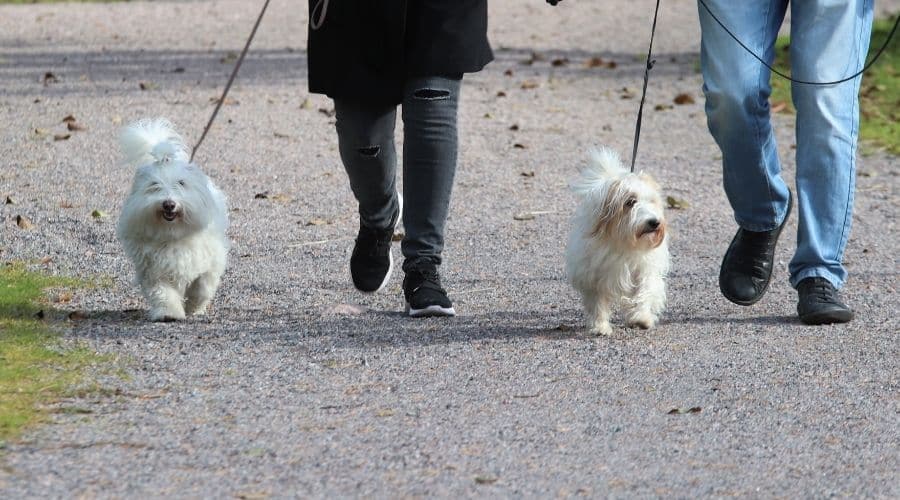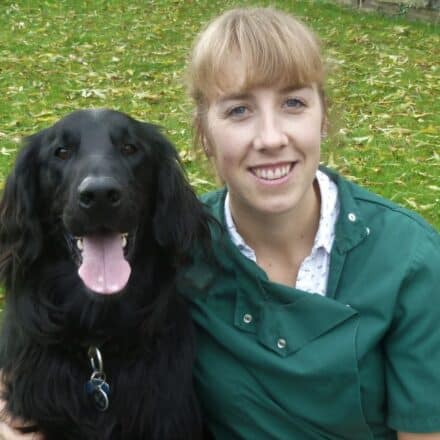Dogs need walks. Everyone knows this, but what might not be so clear is how often your dog needs to be walked each day. We explore the factors to consider when exercising your pet. We also look at some of the additional benefits of walking, not only for dogs but for us.
Exercise is crucial to maintaining a healthy lifestyle. Dogs need to burn off energy – they are not designed to be couch potatoes. This helps them maintain a healthy muscle mass and good bone strength. The cardiovascular system (heart and lungs) is also kept in shape through exercise.
Walking is one of the main opportunities for your dog to exercise. Regular walks help them maintain a healthy weight. Being overweight and in poor condition makes other issues more likely, such as diabetes, cancer, and joint disease. Don’t forget, exercise is good for us too. It is well documented that walking is a great way for people to help prevent certain chronic health complaints and is important in maintaining fitness.
Benefits Of Walking Your Dog
Walks are an opportunity for your dog to get out of the house and receive some mental stimulation. They gather most of the information about their environment and other animals through their sensitive sense of smell – it’s the dog equivalent of reading the news headlines. So it’s important to let your dog have the opportunity to get a few good sniffs and take some time while out walking.
Under-exercised dogs are more at risk of developing behavioral issues. These animals can become bored and destructive, taking it out on themselves and their surroundings. Stress levels in these animals are higher, which can lead to things like overgrooming and excessive whining.
Walking is also an excellent way of bonding with your dog. Dogs enjoy our company and what could be better than to be by your side, or play games with you while out on a walk?
The benefits to us shouldn’t be underestimated either. Getting out into nature, enjoying some time away from screens and work pressures, and having fun with your dog all help your mental well-being. You may even meet new people and increase your social circle while walking.
How Often Do You Walk Your Dog?

Age
Your dog’s age influences how much exercise they need. Very young puppies only require short walks and frequent naps between bursts of energy and play. Similarly, older dogs start to slow down and may be content with more moderate amounts of exercise. Some of these animals may only need short walks, lasting 10 to 15 minutes, a couple of times a day.
Breed
The breed of dog you own plays a huge part in how often they need walking. Very active breeds may need 1.5–2 hours of exercise (or more) per day, whereas more sedate dogs may only need 30 minutes or more a day, depending on their stamina levels.
Examples of active breeds include many working and large breed type dogs such as:
- Weimaraners
- Vizslas
- Pointers
- Boxers
- Doberman Pinschers
- Border Collies
- Poodles
- Dalmatians
More sedentary breeds tend to be smaller dogs that have been bred for companionship rather than for endurance and stamina:
- Pugs
- Yorkshire Terriers
- Bichon Frise
- Chihuahuas
- Basset Hounds
- Shih Tzus
- Pekingese
Be aware that these are generalizations. You should always monitor your dog’s capabilities and tailor exercise accordingly.
Health Status
Your dog’s health status influences how much walking they can do. A fit and well dog requires more exercise than a dog suffering from an underlying illness. For example, a dog with osteoarthritis may struggle to walk as much as a dog without joint disease. Heart issues or breathing problems can also make walking difficult for some.
Obesity can affect some animals’ ability to exercise, but in turn, exercise can actually help with weight loss. So, a steadily increasing walking program can support these animals in losing pounds safely. Speak to your veterinarian for advice.
Brachycephalic breeds may struggle to exercise compared to longer-nosed dogs. Breeds such as pugs, French bulldogs, and Pekingese have flattened faces and narrowed airways. This can make breathing more difficult, impairing their ability to exercise. They also have difficulty maintaining normal body temperature and are at a higher risk of overheating. This all means that these dogs tend not to be able to endure as much exercise as other breeds.
Personality
Your dog’s personality may also drive how much exercise they want to do. A bouncy, exuberant dog is likely to need longer walks than one with a more laid-back personality. Some of this is driven by the breed of the dog, but there is still variation between animals of the same breed. If your dog still seems full of energy following his walks, then it is likely he needs to go out for longer.
Environmental Conditions
The weather plays a big part in how many walks your dog should get. Very hot weather puts dogs at risk of overheating, so exercise should be limited to the cooler parts of the day to keep your dog safe. This may mean giving them shorter walks, too, so they don’t overdo it.
Very cold, icy, or snowy weather may also mean fewer walks than usual, especially for dogs that are more cold-sensitive like whippets, Salukis, and Mexican hairless dogs.
Rain shouldn’t stop play. If your dog is still up for a walk in the wet weather, then make sure you grab a coat and umbrella. Your dog needs walking all year round, not just on the lovely sunny days.
Be Led By Your Dog
Given all the factors you need to consider, you might still be confused about exactly how many walks your dog needs.
You should tailor the exercise to your pet. Your dog should be tired and satisfied after their walks but not be completely exhausted. If your pet still seems bouncy and ready to go, they need more exercise. You could try going out for a long walk or increasing the number of walks per day.
A tired dog is usually a happy dog and less likely to suffer from behavioral problems. Don’t forget you can also help tire your dog out with some of our alternative forms of exercise (see below).
If you are unsure how in shape your dog is, then try a 20- to 30-minute walk to begin with and see how they get on. This can be built on gradually if your dog is coping well.
How Much Walking Is Too Much?
You should not be aiming to take a young puppy on a two-hour hike for example, and you should not expect an overweight brachycephalic pug to go jogging with you. If your dog is struggling to make it around your chosen circuit, is sitting down for frequent rest periods, and generally seems fatigued, you’ve overdone it.
Alternative Forms Of Exercise

Dogs benefit from other forms of exercise, as well as walking. Including:
Agility
Agility involves negotiating obstacles such as ramps, tunnels, and balancing beams. It can be an excellent way of bonding and communicating with your dog and exercising them. Agility classes are good fun and provide mental stimulation for dogs and humans.
Flyball
Typically border collies were the primary breed seen playing competitive flyball, but now other breeds are getting in on the act too. Dogs need to be quick off the mark and able to coordinate catching the ball with speed. This sport is becoming more popular so look for a nearby group for more information.
Swimming Or Hydrotherapy
Swimming is a low-impact form of exercise. Joints are supported against the effects of gravity, making it a good option for those with painful conditions like arthritis. Working against the resistance of the water is good for building muscle mass and improving fitness. Hydrotherapy is a controlled way of doing this and is a good option for animals with underlying health conditions or recovering from surgery.
But even healthy dogs enjoy swimming. Checking out a stream or the local beach can be a good way of providing alternative exercise, which dogs especially appreciate in warmer weather.
Playing Games In The Yard
Playing with your dog in the garden can still help to burn off energy. Games of tug or playing with interactive puzzle feeders are good ways to keep your dog moving and stimulated. Scavenger hunts, where you hide treats or toys around the house and garden, can be good fun. Small breed dogs also enjoy chasing balls in the park, although you may need more space for a larger breed.
Final Thoughts
How often you should walk your dog depends on several factors, including your own animal’s breed, age, and fitness. Be led by them; they should be tired and satisfied after a walk. If they are still bouncing off the walls, they need more exercise. Don’t forget that other forms of activity can also help you exercise and bond with your dog, so consider exploring these in addition to your usual walks. If you are ever unsure, speak to your veterinarian, who can steer you in the right direction.





